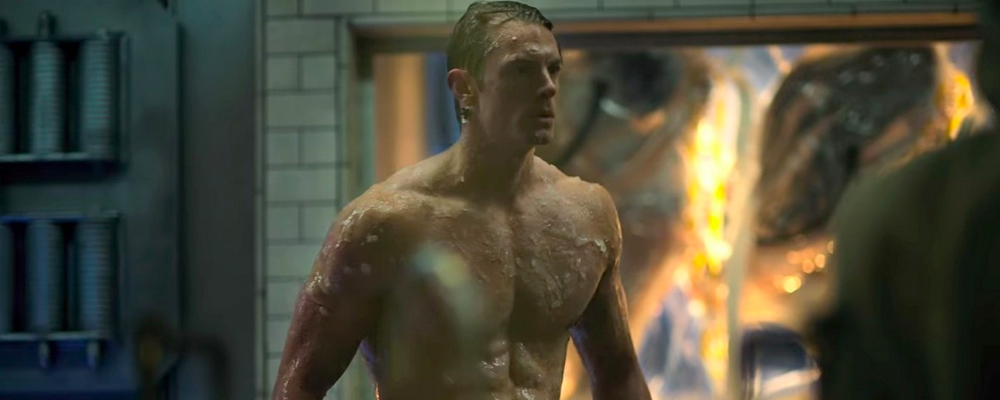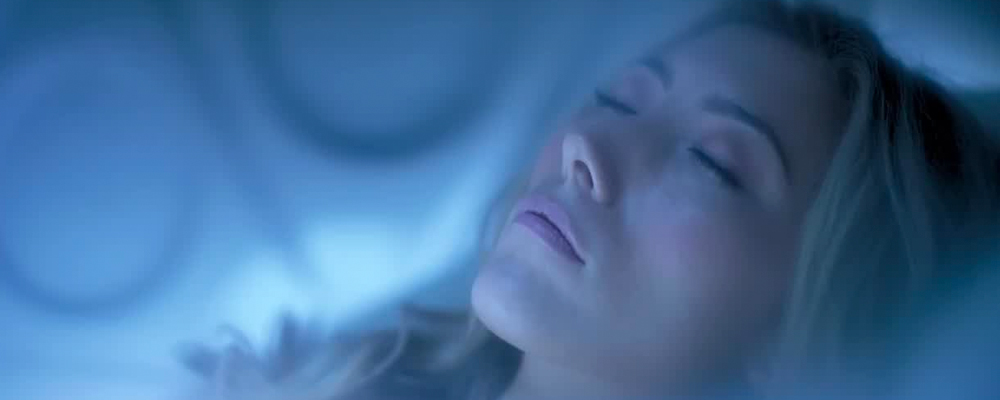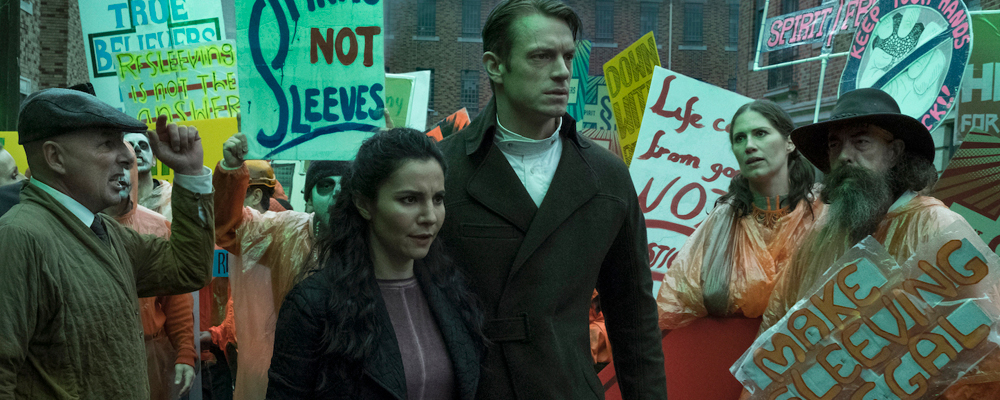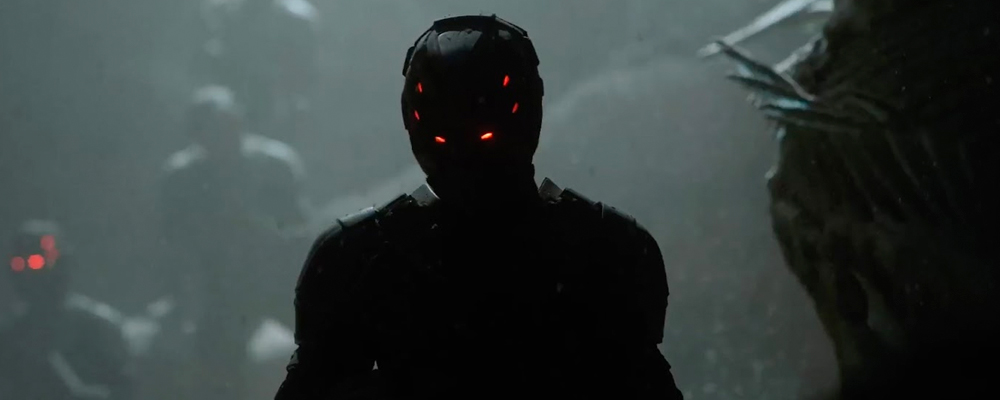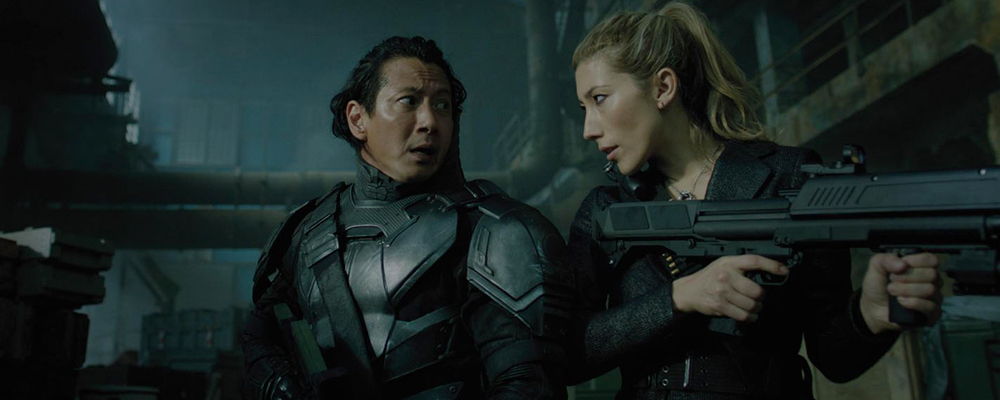Netflix’s ‘Altered Carbon’ Is Dizzying and Entertaining Cyberpunk Noir
Aaron Berke
Netflix’s “Altered Carbon” presents a dizzying array of characters and plot lines. It’s a cyberpunk noir mystery surging with dystopian vibes and super-charged with visual energy. Based on Richard K. Morgan’s classic sci-fi novel, the series tells a tale about people who are no longer bound to their own bodies. It’s a gritty, grungy future filled with body-swapping politics and brutal, violent machinations of the rich and privileged. The series plays with fascinating ideas, but its schizophrenic narrative style convolutes its murder-mystery. Luckily, the wild antics are grounded in the emotional tale of Takeshi Kovacs and his 300-year lifetime.
The world of “Altered Carbon” is one where the human consciousness is no longer destined to die in its original body. It can now be downloaded onto a small chip called a stack, and transferred indefinitely from host to host, called sleeves. The series begins with Takeshi Kovacs’ (Wil Yun Lee) murder. Kovacs was an Envoy, one of the elite fighting forces being trained by a rebel leader, Quel Falconer (Renee Elise Goldsberry). Quel’s rebels fight for the elimination of the stacks and the restoration of the human soul to its original body. 250 years after Kovacs’ murder, he wakes in a new body (played by Joel Kinnaman) to find that the Envoys’ mission failed.
Stacks are now commonplace, and people’s stacks are controlled by the rich and powerful, who have used their vast resources to become immortal, self-christened ‘Gods.’ One of these rich philanderers, Laurens Bancroft (James Purefoy), recruits the new Kovacs to solve the mystery of his own murder. The killing took place before Bancroft re-uploaded to a new sleeve, and he has no memory of the event. Kovacs, who had been branded a terrorist and put on ice, is given this new opportunity by Bancroft to earn his freedom. As Kovacs investigates the mystery, he crosses paths with a feisty young detective, Kristin Ortega (Martha Higareda), who is on a murder investigation of her own, and has a personal history with Riker, Kovacs’ human sleeve.
“Altered Carbon” owes more than a minor debt to Joss Whedon’s “Dollhouse.” Not only are the two shows extraordinarily similar in theme and content, but “Altered Carbon” also features Dichen Lachman, who played a critical role in “Dollhouse.” She features prominently in “Altered Carbon” as Takeshi’s sister, Reileen, and she proves to be critical player in the series’ later episodes. “Carbon” plays like a sequel to “Dollhouse” set 300 years in the future, though “Carbon” is not quite as existential. “Altered Carbon” ultimately appears far more interested in its murder mysteries than the intriguing moral questions that hover over the show.
The through-line of Bancroft’s murder proves to be the series’ most interesting, opening up avenues into exploring the disturbing activities of the rich and powerful. The series’ third episode depicts a married couple fighting each other to the death in front of a crowd of Bancroft’s wealthy friends. The winner gets an upgraded sleeve, while the loser’s sleeve is downgraded. Kovacs’ investigation also leads him to a virtual brothel, where rich patrons like Bancroft are allowed to beat the prostitutes to death as long as they pay to have them re-uploaded to a new sleeve. The investigation turns fascinating corners, revealing uglier and uglier realities to the viewer. “Altered Carbon” is clearly going for commentary on class warfare in America, taking it to its ultimate and horrid end. But the commentary begins and ends with shock value, disturbing the viewer but only teasing at a deeper context.
Ultimately any chance for insightful commentary is lost in the myriad of sub-plots, some of which work better than others. Ortega is an intriguing character, and her increasingly emotional relationship with Kovacs pushes the narrative forward. But she also gets lost in her own sub-plot as she investigates the mysterious murder of a prostitute named Mary Lou, who was a friend of Ortega’s. The mystery eventually becomes critical to the overarching story, but the problem is that its structured in a way that directly contrasts with Kovacs’ investigation. Rather than it being a deliberate contrast, the two investigations simply confuse each other. When the show cuts back and forth between the two, it doesn’t give a clear narrative preference to one over the other, resulting in a confusing gloss of information. We’re often never sure which facts are crucial to which investigation.
This speaks to the biggest problem with “Altered Carbon,” which is its schizophrenic cutting style. It haphazardly jumps from narrative to narrative without much indication of which one is going to take precedence in any given episode. The good news is that most of the sub-plots are compelling enough that they warrant digesting the roughly-delivered information. Kovacs recruits the help of weapons expert Vernon Elliot, whose daughter Lizzie was brutally murdered and who’s essence is trapped in a virtual trauma loop. Elliot attempting to put his family back together is an important counter-narrative to the priorities of the rich and soulless. This also provides a fascinating use for Chris Connor’s Poe, an AI program based on the spirit of Edgar Allen Poe. He uses a psychological fix program to help bring Lizzie out of her loop. Poe is a delightful sidekick and reliable source of humor, helping to balance out the series’ often overwhelmingly bleak moments.
Kovacs’ backstory is also fascinating, and the series’ seventh episode takes a departure from the murder mystery to focus on his original life 250 years in the past. The episode focuses on Kovacs’ relationship with his sister. The renewed focus on two characters helps ground the narrative and consequently it’s one of “Altered Carbon’s” best episodes. We learn how Kovacs and Reileen were separated at a young age, with Kovacs being recruited by the U.N. Protectorate’s special-ops forces and Reileen stolen by the Yakuza. They eventually reunite in a delightful sequence in which they slaughter both of their original teams rather than turn on each other. The strength of the siblings’ relationship carries forward into the back half of the series, grounding the remaining episodes with emotional weight that had been missing from the first half.
Wil Yun Lee delivers a remarkable performance as past Kovacs, his deeply layered turn offset by Kinnaman’s gruff, rough-around-the-edges portrayal in present day. Both actors bring different qualities to the role, with Kinnaman’s rugged exterior ideal for playing the typical noir hero, while the pain and loss of Kovacs’ backstory requires a broader emotional range, which Lee delivers with finesse. There’s an inherent awkwardness in transitioning from an Asian actor to a white actor playing the same character. Indeed, many might scream ‘white washing’ the moment they see “Altered Carbon.” In this case the racial shift is justified as it’s simply an authentic translation of the novel. There is, however, a missed opportunity here to use the transition from Asian to white male to address the deeper questions about identity that the series poses. In this world of limitless immortality, people change ethnicity, age and even gender. Vernon’s wife returns to him as man. Ortega’s deceased grandmother comes back as a young street thug. Such changes prompt interesting questions about the nature of human identity. But like many of the series’ deeper questions, “Altered Carbon” merely flirts with the idea before leaving it the lurch, quickly moving on to its next sub-plot.
The element that best anchors “Altered Carbon” is its visual pizazz. The series’ neon color palette is pleasing to the senses, the drab futuristic world constantly lit up by bright displays of blinking light schemes. The action sequences often work in tandem with the frenetic visual flair, and “Altered Carbon” boasts some of modern TV’s most pulpy and delightfully ridiculous action bouts. The married couple fight to the death in anti-gravity chamber. Kovacs battles a psychotic version of himself wearing his old Asian body but speaking in a Russian accent. Best of all, Ortega battles an endless series of naked clones wielding samurai swords. Such moments are so visually distinct that they ground the viewer in their brazen cyberpunk zest, letting all the narrative clutter fall away.
“Altered Carbon” ultimately works because of its visual flair, strong characters and intriguing mysteries. The narrative is often a messy jumble, and it can be frustrating to pick through. But everything comes together by the season finale, putting the conflicting plotlines in perspective and bringing the season to a satisfying resolution. Although many of the deeper themes go unexplored, “Altered Carbon” leaves the door open for future seasons to do the heavy lifting. For now, season one of this cyberpunk noir leaves something to be desired but offers plenty of sheer spectacle and a compelling central character in Kovacs. Perhaps the best quality of “Altered Carbon” is its authenticity. Much like Kovacs, who switches bodies but remains firmly himself, the series knows exactly what it wants to be. “Altered Carbon” is a dizzying display of conflict, but it wears its colors proudly, plunging forward with gleeful, unapologetic abandon.
All ten episodes of seaon one of “Altered Carbon” available Feb. 22 on Netflix.

